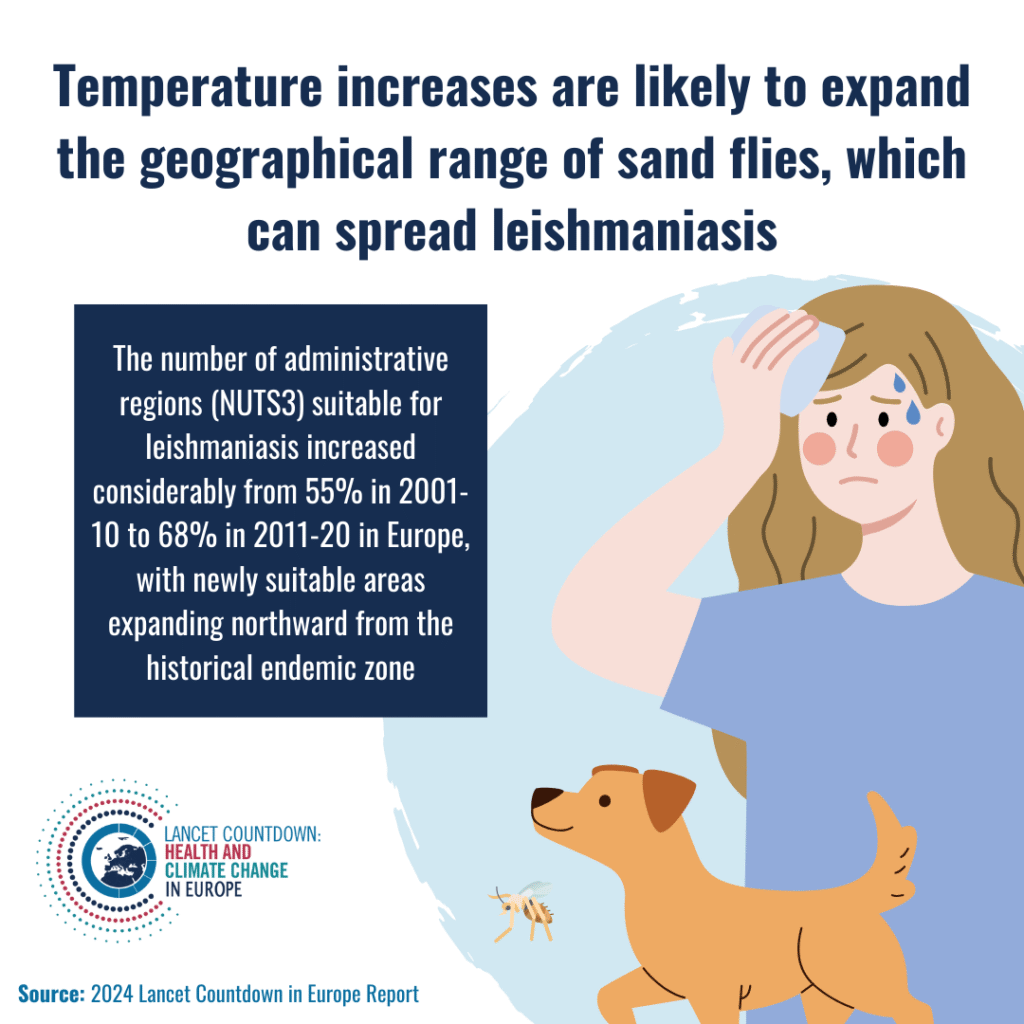The 2024 Europe report of the Lancet Countdown on health and climate change
Europe is experiencing unprecedented warming and an increase in extreme climatic events, including record-breaking heat, droughts, and floods, as seen in 2022 and 2023. The 2024 Europe report of the Lancet Countdown on health and climate change warns that without swift and drastic action, climate change will continue to accelerate, causing irreversible impacts on human health and well-being worldwide.
While some political progress has been made in Europe through initiatives like the European Climate Law and the EU Adaptation Strategy, the report argues that these efforts, along with international agreements such as those from COP28, are insufficient. Notably, the Euro 7 Emissions Standards and the Industrial Emissions Directive are still inadequate. The report also stresses the importance of considering equity and justice
The Lancet Countdown
The Lancet Countdown is an international research collaboration that tracks the health impacts of climate change and monitors the progress of countries in addressing the climate crisis. It brings together experts from various disciplines to provide an annual assessment of the relationship between health and climate change, aiming to inform policy and drive action.

This is the second report of its kind, and it tracks progress on health and climate change in Europe. It uses 42 indicators across five domains, with researchers from Climate-Health Cluster projects: CLIMOS, and IDAlert projects contributing to the Leishmania indicators.
CLIMOS project authors:
IDAlert project authors:

The methods behind indicators presented in the 2022 report have been improved, and nine new indicators have been added, covering leishmaniasis, ticks, food security, health-care emissions, production and consumption-based emissions, clean energy investment, and scientific, political, and media engagement with climate and health. Considering that negative climate-related health impacts and the responsibility for climate change are not equal at the regional and global levels, this report also endeavours to reflect on aspects of inequality and justice by highlighting at-risk groups within Europe and Europe’s responsibility for the climate crisis.
Read the full report in this link
Indicator 1.3.5: climatic suitability for leishmaniasis

Climatic suitability for West Nile virus, dengue, Leishmania infantum, and Ixodes ricinus ticks in Europe

![[ENG] 1.1.1 Vulnerability to heat exposure](https://climos-project.eu/wp-content/uploads/2025/08/ENG-1.1.1-Vulnerability-to-heat-exposure-1024x1024.png)
![[ENG] 1.1.2 Exposure of vulnerable populations to heatwaves](https://climos-project.eu/wp-content/uploads/2025/08/ENG-1.1.2-Exposure-of-vulnerable-populations-to-heatwaves-1024x1024.png)
![[ENG] 1.1.3 Physical activity related heat stress risk](https://climos-project.eu/wp-content/uploads/2025/08/ENG-1.1.3-Physical-activity-related-heat-stress-risk-1024x1024.png)
![[ENG] 1.1.4 Heat-related mortality](https://climos-project.eu/wp-content/uploads/2025/08/ENG-1.1.4-Heat-related-mortality--1024x1024.png)
![[ENG] 1.2.1 Wildfire smoke](https://climos-project.eu/wp-content/uploads/2025/08/ENG-1.2.1-Wildfire-smoke-1024x1024.png)
![[ENG] 1.2.2 Drought](https://climos-project.eu/wp-content/uploads/2025/08/ENG-1.2.2-Drought-1024x1024.png)
![[ENG] 1.3.1 Climatic suitability for Vibrio](https://climos-project.eu/wp-content/uploads/2025/08/ENG-1.3.1-Climatic-suitability-for-Vibrio-1024x1024.png)
![[ENG] 1.3.2 Climatic suitability for West Nile virus](https://climos-project.eu/wp-content/uploads/2025/08/ENG-1.3.2-Climatic-suitability-for-West-Nile-virus-1024x1024.png)
![[ENG] 1.3.3 Climatic suitability for dengue, chikungunya and Zika](https://climos-project.eu/wp-content/uploads/2025/08/ENG-1.3.3-Climatic-suitability-for-dengue-chikungunya-and-Zika-1024x1024.png)
![[ENG] 1.3.4 Climatic suitability for malaria](https://climos-project.eu/wp-content/uploads/2025/08/ENG-1.3.4-Climatic-suitability-for-malaria-1024x1024.png)
![[ENG] 1.3.5 Climatic Suitability for leishmaniasis](https://climos-project.eu/wp-content/uploads/2025/08/ENG-1.3.5-Climatic-Suitability-for-leishmaniasis-1024x1024.png)
![[ENG] 1.3.6 Climatic suitability for ticks](https://climos-project.eu/wp-content/uploads/2025/08/ENG-1.3.6-Climatic-suitability-for-ticks-1024x1024.png)
![[ENG] 1.4.1 Allergenic trees](https://climos-project.eu/wp-content/uploads/2025/08/ENG-1.4.1-Allergenic-trees-1024x1024.png)
![[ENG] 1.5.1 Food security and undernutrition](https://climos-project.eu/wp-content/uploads/2025/08/ENG-1.5.1-Food-security-and-undernutrition-1024x1024.png)
![[ENG] 2.1.1 National vulnerability and adaptation assessments](https://climos-project.eu/wp-content/uploads/2025/08/ENG-2.1.1-National-vulnerability-and-adaptation-assessments-1024x1024.png)
![[ENG] 2.1.2 National adaptation plans for health](https://climos-project.eu/wp-content/uploads/2025/08/ENG-2.1.2-National-adaptation-plans-for-health-1024x1024.png)
![[ENG] 2.1.3 City - level climate change risks assessments](https://climos-project.eu/wp-content/uploads/2025/08/ENG-2.1.3-City-level-climate-change-risks-assessments-1024x1024.png)
![[ENG] 2.2.1 Climate information for health](https://climos-project.eu/wp-content/uploads/2025/08/ENG-2.2.1-Climate-information-for-health-1024x1024.png)
![[ENG] 2.2.2 Green space](https://climos-project.eu/wp-content/uploads/2025/08/ENG-2.2.2-Green-space-1024x1024.png)
![[ENG] 2.2.3 Air conditioning benefits and harms](https://climos-project.eu/wp-content/uploads/2025/08/ENG-2.2.3-Air-conditioning-benefits-and-harms-1024x1024.png)
![[ENG] 3.1.1 Carbon intensity of the energy system](https://climos-project.eu/wp-content/uploads/2025/08/ENG-3.1.1-Carbon-intensity-of-the-energy-system-1024x1024.png)
![[ENG] 3.1.2 Coal phase-out](https://climos-project.eu/wp-content/uploads/2025/08/ENG-3.1.2-Coal-phase-out-1024x1024.png)
![[ENG] 3.1.3 Renewable and zero-carbon emission electricity](https://climos-project.eu/wp-content/uploads/2025/08/ENG-3.1.3-Renewable-and-zero-carbon-emission-electricity-1024x1024.png)
![[ENG] 3.2.1 Premature mortality attributable to ambient fine particles](https://climos-project.eu/wp-content/uploads/2025/08/ENG-3.2.1-Premature-mortality-attributable-to-ambient-fine-particles-1024x1024.png)
![[ENG] 3.2.2 Production-based and consumption-based attribution of CO2 and PM2.5 emissions](https://climos-project.eu/wp-content/uploads/2025/08/ENG-3.2.2-Production-based-and-consumption-based-attribution-of-CO2-and-PM2.5-emissions-1024x1024.png)
![[ENG] 3.3 Sustainable and healthy transport](https://climos-project.eu/wp-content/uploads/2025/08/ENG-3.3-Sustainable-and-healthy-transport-1024x1024.png)
![[ENG] 3.4.1 Life cycle emissions from food demand, production and trade](https://climos-project.eu/wp-content/uploads/2025/08/ENG-3.4.1-Life-cycle-emissions-from-food-demand-production-and-trade-1024x1024.png)
![[ENG] 3.4.2 Sustainable diets](https://climos-project.eu/wp-content/uploads/2025/08/ENG-3.4.2-Sustainable-diets-1024x1024.png)
![[ENG] 3.5 Health sector emissions and harms](https://climos-project.eu/wp-content/uploads/2025/08/ENG-3.5-Health-sector-emissions-and-harms-1024x1024.png)
![[ENG] 4.1.1 Economic losses due to climate-related extreme events](https://climos-project.eu/wp-content/uploads/2025/08/ENG-4.1.1-Economic-losses-due-to-climate-related-extreme-events-1024x1024.png)
![[ENG] 4.1.2 Change in labour supply](https://climos-project.eu/wp-content/uploads/2025/08/ENG-4.1.2-Change-in-labour-supply-1024x1024.png)
![[ENG] 4.1.3 Impact of heat on economic activity](https://climos-project.eu/wp-content/uploads/2025/08/ENG-4.1.3-Impact-of-heat-on-economic-activity-1024x1024.png)
![[ENG] 4.1.4 Monetised value of unhealthy diets](https://climos-project.eu/wp-content/uploads/2025/08/ENG-4.1.4-Monetised-value-of-unhealthy-diets-1024x1024.png)
![[ENG] 4.2.1 Net value of fossil fuel subsidies and carbon prices](https://climos-project.eu/wp-content/uploads/2025/08/ENG-4.2.1-Net-value-of-fossil-fuel-subsidies-and-carbon-prices-1024x1024.png)
![[ENG] 4.2.2 Clean energy investment](https://climos-project.eu/wp-content/uploads/2025/08/ENG-4.2.2-Clean-energy-investment-1024x1024.png)
![[ENG] 5.1.1 Coverage of health and climate Change in scientific articles](https://climos-project.eu/wp-content/uploads/2025/08/ENG-5.1.1-Coverage-of-health-and-climate-Change-in-scientific-articles-1024x1024.png)
![[ENG] 5.1.2 Coverage of the health impacts of anthropogenic climate change](https://climos-project.eu/wp-content/uploads/2025/08/ENG-5.1.2-Coverage-of-the-health-impacts-of-anthropogenic-climate-change-1024x1024.png)
![[ENG] 5.2 Individual engagement with health and climate change on social media](https://climos-project.eu/wp-content/uploads/2025/08/ENG-5.2-Individual-engagement-with-health-and-climate-change-on-social-media-1024x1024.png)
![[ENG] 5.3.1 Engagement with health and climate change in the European Parliament](https://climos-project.eu/wp-content/uploads/2025/08/ENG-5.3.1-Engagement-with-health-and-climate-change-in-the-European-Parliament-1024x1024.png)
![[ENG] 5.3.2 Political engagement with health and climate change on social media](https://climos-project.eu/wp-content/uploads/2025/08/ENG-5.3.2-Political-engagement-with-health-and-climate-change-on-social-media-1024x1024.png)
![[ENG] 5.4 Corporate sector engagement with health and climate change](https://climos-project.eu/wp-content/uploads/2025/08/ENG-5.4-Corporate-sector-engagement-with-health-and-climate-change-1024x1024.png)
![[ENG] 5.5 Media engagement with health and climate change](https://climos-project.eu/wp-content/uploads/2025/08/ENG-5.5-Media-engagement-with-health-and-climate-change-1024x1024.png)